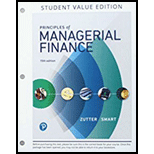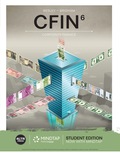
Concept explainers
Learning Goals 2, 5
ST5-1
- a. What amount would Ms. Martin have after 3 years, leaving all interest paid on deposit, in each bank?
- b. What effective annual rate (EAR) would she earn in each of the banks?
- c. On the basis of your findings in parts a and b, which bank should Ms. Martin deal with? Why?
- d. If a fourth bank (bank D), also with a 4% stated interest rate, compounds interest continuously, how much would Ms. Martin have after 3 years? Does this alternative change your recommendation in part c? Explain why or why not.
Subpart (a)
To calculate: Future value.
Introduction:
Future value (FV): The future value refers the value of present amount at a future date.
Answer to Problem 5.1STP
Bank A= $11,250
Bank B= $11,260
Bank C= $11,270
Explanation of Solution
Given:
Present value, $10,000, interest rate 4%, time period 3.
Calculation
The general formula for calculating future values is shown below.
Substitute the values in equation (1) to calculate future values of $10,000.
FV is $11,250.
By using the same equation (1), the future value of deposit $10,000 in each bank is shown below.
Table 1 shows the future value.
Table 1
| Bank | Present value | Years to compound | Interest | Future value |
| A | $10,000 | 3 years | 4% | $11,250 |
| B | $10,000 | Two times in a year | 4% | $11,260 |
| C | $10,000 | Quarterly (4) | 4% | $11,270 |
Subpart (b)
To calculate: Effective annual rate.
Introduction:
Effective annual rate (EAR): Effective annual rate refers, it is the annual rate of interest which is actually paid or earned.
Answer to Problem 5.1STP
Bank A= 4%
Bank B= 4.04%
Bank C= 4.06%
Explanation of Solution
Given:
Interest rate 4%, time period 3.
Calculation
The general formula for calculating the effective annual rate is shown below.
Substitute the values in equation (2) to calculate the EAR for deposit $10,000 in bank A.
EAR is 4%.
By using the same equation (1), the EAR for each case is shown below.
Table 2 shows the EAR.
Table 2
| Bank | Years to compound | Interest | EAR |
| A | 3 years | 4% | 4% |
| B | Two times in a year | 4% | 4.04% |
| C | Quarterly (4) | 4% | 4.06% |
Subpart (c)
To discuss: Which bank the investor will choose.
Answer to Problem 5.1STP
Bank C
Explanation of Solution
The investor will choose bank C, because, the compounding frequency is 4 (quarterly). Higher the compounding frequency increases the future value of deposit. Thus, bank C is best.
Subpart (d)
To calculate: Future value.
Introduction:
Future value (FV): The future value refers the value of present amount at a future date.
Answer to Problem 5.1STP
$11,274.97
Explanation of Solution
Given:
Present value, $10,000, interest rate 4%, time period 3.
Calculation
In bank D, the interest is compounded continuously. Calculation of future values of $10,000 with continues compounding is shown below.
The value of “e” is approximately “2.7183”.
FV is $11,274.97.
Comparing Bank D with C, bank D is better than C, because, the compounding frequency and future value obtained in bank D is higher than bank C. thus, bank D is a good alternative.
Want to see more full solutions like this?
Chapter 5 Solutions
Principles of Managerial Finance, Student Value Edition Plus MyLab Finance with Pearson eText - Access Card Package (15th Edition) (Pearson Series in Finance)
- Don't used hand raiting and don't used Ai solutionarrow_forwardRevision Questions for This Week Suppose you see the following regression table: earnings Coef. Std. Err. married 7737.006 265.0139 _cons 9058.677 210.3906 1. What are the 95 confidence intervals for (i) the intercept, (ii). the slope, rounded to the second decimal place? 2. Are any of the coefficients statistically significant at the 5% level of significance? Explain. 3. Return to the t-statistic example from earlier (below). Do either of the 95% confidence intervals contain zero? Should they? log(wage) = .284.092 educ· (.104) (.007)arrow_forwardKenji’s Tax Scenario Kenji is a young professional with taxable income of $138,000 as an advertising account executive. What is Kenji’s total tax liability? (Note: Round your answer to the nearest cent, if necessary.) What is Kenji’s top marginal tax rate? What is Kenji's average tax rate?arrow_forward
- 1. A project manager is using the payback method to make the final decision on which project to undertake. The company has a 9% required rate of return and expects a 5% rate of inflation for the following five years. i. ii. What is the non-discounted payback of a project that has cash flows as shown in the table? What is the rate of return? (use equation given in class) Cash Outflow Cash inflow Net Flow Year 10 $500,000 0 1 12. * 0 $75,000 & $50,000 $150,000 3 $200,000 $350,000 4 0 $150,000 5 0 $750,000arrow_forwardProblem 4. Consider the following balance sheet for Watchover Savings Incorporated (in millions): Assets Liabilities and Equity Floating-rate mortgages (currently 12% per annum) Now deposits (currently 8% per $ 82 annum) $ 116 30-year fixed-rate loans (currently 9% per annum) 5-year time deposits (currently 8% per 101 annum) 29 Equity 38 $ 183 Total $ 183 Total a. What is Watchover's expected net interest income at year-end? b. What will be the net interest income at year-end if interest rates rise by 3 percent? c. Using the one-year cumulative repricing gap model, what is the change in the expected net interest income for a 3 percent increase in interest rates?arrow_forwardYou are given the following information for Frankenson Pizza Company: Sales = $72,000; Costs = $32,300; Addition to retained earnings = $6,500; Dividends paid = $2,220; Interest expense = $5,200; Tax rate = 23 percent. Calculate the depreciation expense. Note: Do not round intermediate calculations and round your answer to the nearest whole number, e.g., 32.arrow_forward
- Assume coupons are paid annually. Here are the prices of three bonds with 10-year maturities. Assume face value is $100. Bond Coupon (%) Price (%) 2 4 8 81.62 98.39 133.42 a. What is the yield to maturity of each bond? b. What is the duration of each bond? Complete this question by entering your answers in the tabs below. Required A Required B What is the yield to maturity of each bond? Note: Do not round intermediate calculations. Enter your answers as a percent rounded to 2 decimal places. Bond Coupon (%) YTM 2 % 4 8 % % Required A Required R Required B What is the duration of each bond? Note: Do not round intermediate calculations. Round your answers to 2 decimal places. Bond Coupon (%) Duration 2 years 4 years 8 yearsarrow_forwardTwo building owners - Alice and Bob - each own a building worth $1,000,000. They are considering forming a mutual insurance pool. Based on historical data, there are three possible fire damage scenarios for each building in a given year: No damage: 85% probability Partial damage: 12% probability, with repair costs of $200,000 Total loss: 3% probability, with a cost of $1,000,000 Calculate the standard deviation of the loss of each owner with pooling (2 buildings together)arrow_forwardCritically evaluate the usefulness of Net Present Value as an investment appraisal.arrow_forward
- Sales are $2.90 million, cost of goods sold is $590,000, depreciation expense is $148,000, other operating expenses are $298,000, addition to retained earnings is $1,126,625, dividends per share are $1, tax rate is 21 percent, and number of shares of common stock outstanding is 88,000. LaTonya's Flop Shops has no preferred stock outstanding. Use the above information to calculate the times interest earned ratio for LaTonya's Flop Shops, Incorporated. Note: Round your answer to 2 decimal places. Interest earned timesarrow_forwardTwo building owners - Alice and Bob - each own a building worth $1,000,000. They are considering forming a mutual insurance pool. Based on historical data, there are three possible fire damage scenarios for each building in a given year: No damage: 85% probability Partial damage: 12% probability, with repair costs of $200,000 Total loss: 3% probability, with a cost of $1,000,000 Calculate the standard deviationarrow_forwardWhat is the role of the researcher, population and sampling, and data collection, could you help explain each one of them? How to start working on the population structures essential to research? What are the structured ways in which to present key research elements?arrow_forward
 Financial Accounting: The Impact on Decision Make...AccountingISBN:9781305654174Author:Gary A. Porter, Curtis L. NortonPublisher:Cengage Learning
Financial Accounting: The Impact on Decision Make...AccountingISBN:9781305654174Author:Gary A. Porter, Curtis L. NortonPublisher:Cengage Learning Pfin (with Mindtap, 1 Term Printed Access Card) (...FinanceISBN:9780357033609Author:Randall Billingsley, Lawrence J. Gitman, Michael D. JoehnkPublisher:Cengage Learning
Pfin (with Mindtap, 1 Term Printed Access Card) (...FinanceISBN:9780357033609Author:Randall Billingsley, Lawrence J. Gitman, Michael D. JoehnkPublisher:Cengage Learning Cornerstones of Financial AccountingAccountingISBN:9781337690881Author:Jay Rich, Jeff JonesPublisher:Cengage Learning
Cornerstones of Financial AccountingAccountingISBN:9781337690881Author:Jay Rich, Jeff JonesPublisher:Cengage Learning Intermediate Accounting: Reporting And AnalysisAccountingISBN:9781337788281Author:James M. Wahlen, Jefferson P. Jones, Donald PagachPublisher:Cengage Learning
Intermediate Accounting: Reporting And AnalysisAccountingISBN:9781337788281Author:James M. Wahlen, Jefferson P. Jones, Donald PagachPublisher:Cengage Learning




